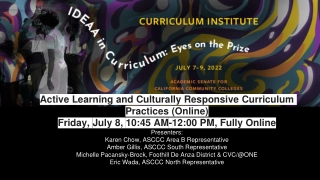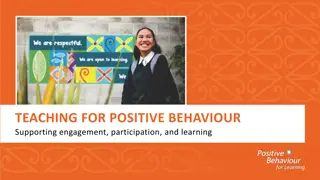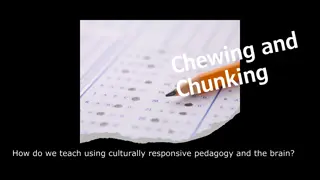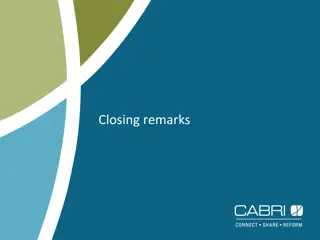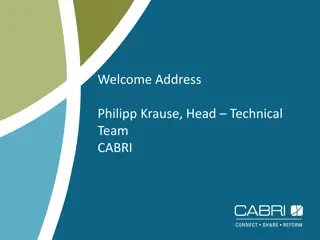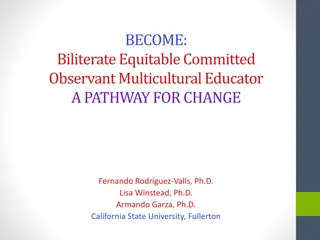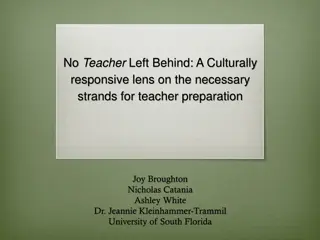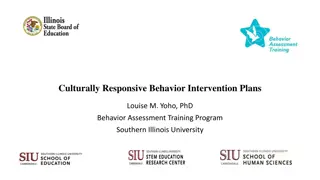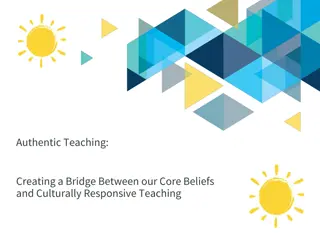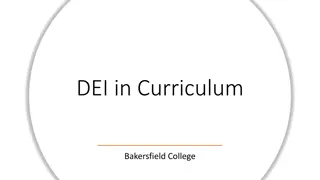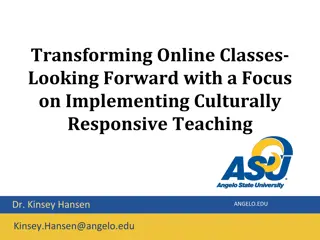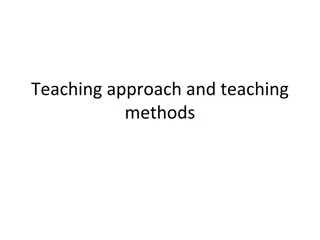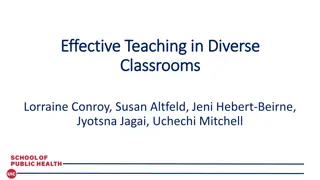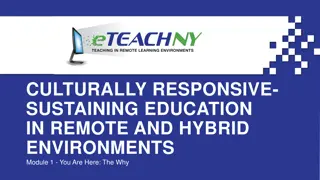Culturally Responsive Teaching Activities
Enhance cultural understanding in the classroom with culturally responsive teaching activities like student interviews and exploring diverse backgrounds through engaging questions. Foster acceptance, communication, and interpersonal skills in a supportive learning environment.
Download Presentation

Please find below an Image/Link to download the presentation.
The content on the website is provided AS IS for your information and personal use only. It may not be sold, licensed, or shared on other websites without obtaining consent from the author.If you encounter any issues during the download, it is possible that the publisher has removed the file from their server.
You are allowed to download the files provided on this website for personal or commercial use, subject to the condition that they are used lawfully. All files are the property of their respective owners.
The content on the website is provided AS IS for your information and personal use only. It may not be sold, licensed, or shared on other websites without obtaining consent from the author.
E N D
Presentation Transcript
Think about the following when creating culturally sustaining spaces: Your library Think about which books students will see on the first day of class. Share your book collection with students Try to read books that are from diverse authors. Art Visuals are powerful. Sounds and Music Do you play music in your classroom? During the beginning, middle or end of your class? Give context to the singer, group, or performers. Activities Think about what activities you can deliver in class that will support culturally sustaining spaces. Let s review some activities
Culturally Responsive Teaching Activity One: The Interview Objective: The purpose of this activity is for teachers and students to learn more about each other. By asking students to interview one another, they will get an opportunity to learn about different cultures, backgrounds, household compositions and more. Process: There are approximately 25 weeks of school in one academic year. Depending on your classroom size, you can identify a student each week. The teacher should go first to model the activity. Identify an interviewer and interviewee. Have students ask questions from a pre-selected list of questions. Outcomes: By allowing students to share their experiences you are creating a classroom culture that sustains and permeates acceptance and understanding. You are also tapping into soft skills such as communication, leadership, teamwork, adaptability, and interpersonal skills. Excellent life skills to have for work and life.
Culturally Responsive Teaching Sample Interview Questions 1) What is your given name and how did you get your name? 2) If you had to choose one word to describe you, what would you choose and why? 3) Tell me about your last school, and what is your favorite memory? 4) Describe your neighborhood and community. 5) What is one thing you respect about your mother or father or guardian? 6) Describe your favorite food. 7) Currently, what is your favorite subject and why? 8) Do you have a role model? Why do you look up to him or her? 9) Do you have a favorite sport, hobby or activity? 10) In ten years where do you see yourself living, going to school, or career choice? 11) If I had to ask a friend or family member about you, what would they tell me? 12) What problem would you like to solve in this world and why? 13) What is something most people don t know about you?
Culturally Responsive Teaching Activity Two: The Interview (Parent Edition) Objective: The purpose of this activity is for students to learn more about his or her parent/guardian. There is a wealth of knowledge that we can learn from our parents. Students can learn more about their origins from this primary source. If a parent is not available, students are encouraged to interview a grandparent or relative. Process: Give students a handout with questions. They should record their findings and be prepare to share with the class. Outcomes: By allowing students to record the experiences and origins of their parents (or relatives), they are becoming researchers. This is a creative way to introduce students to research. You are putting the student at the center of their learning.
Culturally Responsive Teaching Sample Interview Questions (Parent Edition) 1) What is your given name and how did you get your name? 2) If you had to choose one word to describe you, what would you choose and why? 3) Where and when were you born? 4) Do you have any siblings? Who are they? 5) What is your current career title and profession? 6) Describe your favorite food. 7) Currently, What is your favorite tv show, book, or music genre and why? 8) Do you have a role model? Why do you look up to that person? 9) Do you have a favorite sport, hobby, or activity? 10) What is your greatest accomplishment? 11) If I had to ask a friend or family member about you, what would they tell me? 12) What problem would you like to see solved in this world and why? 13) What is something that most people don t know about you? 14) What are some of your best memories as a child?
Culturally Responsive Teaching Activity Three: Guest Speakers Objective: The purpose for this activity is to have students learn more about others through careers, experiences, and perspectives. A guest speaker can bring content and passion to history, geography, and social studies lessons, capturing student interest. Process: Think of the various stakeholders that live and work in our community or people in our network. Invite professionals to speak about their career choices, academic journeys, and life trajectories. What advice can they give students regarding career choices or life? Outcomes: Allow students to be inquisitive about diversity and people. By allowing them to ask questions and learn from different sources, you may open their awareness about the world they live in. Be sure to discuss your outcomes with the guest speaker. Review expectations, questions, and what you would like to see happen as a result of their interaction with your students.
Culturally Responsive Teaching Potential Guest Speakers 1) A teacher from a different nationality. 2) A veteran. 3) Professionals from diverse career backgrounds (doctors, lawyers, scientists, etc.). 4) A college student (ideally a junior or senior). 5) A person who has experienced a difficult moment in history (ex: holocaust survivor). Be sure to review content, historical perspectives and key objectives prior to inviting a guest speaker that will speak to his or her experience about historical events. 6) An artist or athlete. 7) An entrepreneur or business owner. You should prepare your students before any guest speaker is invited. Review the do s and don ts of questions (ex: How much money do you make? What is your sexual orientation? Are you single or married)? Keep questions focused on the topic.
Culturally Responsive Teaching Activity Four: The Circle Objective: This activity you can do with any group of students to help them recognize similarities and differences between peers. Students may look like them or come from a different background. Through this exercise students can find common ground through experiences. Process: Have students form a circle. For each I statement, students should step forward, raise both hands, or give a thumbs up . Read all of the I statements, have students observe what is happening around them. End the activity by asking students what they learned from their peers. Outcomes: By practicing active listening, you are enabling students to use their auditory and observation skills. Students will use their critical thinking skills to identify differences and similarities in their classroom environment.
Culturally Responsive Teaching I Statements 1) I am an only child. 2) I have more than three siblings. 3) I was raised in a rural or city area etc. 4) I have at least one pet. 5) I have never been outside of the country. 6) I have come from or have travelled to another country. 7) I plan to go to college. 8) I plan on starting my own business. 9) I like to talk. 10) I prefer to listen. 11) I can speak a second language. 12) I can dance. 13) I can sing. 14) I can draw. You may create different questions.


